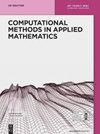Nonlinear PDE Models in Semi-relativistic Quantum Physics
IF 1.2
4区 数学
Q3 MATHEMATICS, APPLIED
引用次数: 3
Abstract
Abstract We present the self-consistent Pauli equation, a semi-relativistic model for charged spin- 1 / 2 1/2 particles with self-interaction with the electromagnetic field. The Pauli equation arises as the O ( 1 / c ) O(1/c) approximation of the relativistic Dirac equation. The fully relativistic self-consistent model is the Dirac–Maxwell equation where the description of spin and the magnetic field arises naturally. In the non-relativistic setting, the correct self-consistent equation is the Schrödinger–Poisson equation which does not describe spin and the magnetic field and where the self-interaction is with the electric field only. The Schrödinger–Poisson equation also arises as the mean field limit of the 𝑁-body Schrödinger equation with Coulomb interaction. We propose that the Pauli–Poisson equation arises as the mean field limit N → ∞ N\to\infty of the linear 𝑁-body Pauli equation with Coulomb interaction where one has to pay extra attention to the fermionic nature of the Pauli equation. We present the semiclassical limit of the Pauli–Poisson equation by the Wigner method to the Vlasov equation with Lorentz force coupled to the Poisson equation which is also consistent with the hierarchy in 1 / c 1/c of the self-consistent Vlasov equation. This is a non-trivial extension of the groundbreaking works by Lions & Paul and Markowich & Mauser, where we need methods like magnetic Lieb–Thirring estimates.半相对论量子物理中的非线性PDE模型
摘要给出了自洽Pauli方程,这是自旋- 1/2 /2带电粒子与电磁场相互作用的半相对论模型。泡利方程产生于相对论性狄拉克方程的O(1/c) O(1/c)近似。完全相对论的自洽模型是狄拉克-麦克斯韦方程,其中对自旋和磁场的描述是自然产生的。在非相对论的情况下,正确的自洽方程是Schrödinger-Poisson方程,它不描述自旋和磁场,而且自洽作用只与电场有关。Schrödinger-Poisson方程也作为具有库仑相互作用的𝑁-body Schrödinger方程的平均场极限出现。我们提出泡利-泊松方程的出现是具有库仑相互作用的线性𝑁-body泡利方程的平均场极限N→∞N \to\infty,其中必须特别注意泡利方程的费米子性质。用Wigner方法给出了Pauli-Poisson方程与Lorentz力耦合的Vlasov方程的半经典极限,该极限也符合自洽Vlasov方程的1/c 1/c层次。这是Lions & Paul和Markowich & Mauser开创性工作的非平凡延伸,在这些工作中,我们需要像磁性Lieb-Thirring估计这样的方法。
本文章由计算机程序翻译,如有差异,请以英文原文为准。
求助全文
约1分钟内获得全文
求助全文
来源期刊

Computational Methods in Applied Mathematics
MATHEMATICS, APPLIED-
CiteScore
2.40
自引率
7.70%
发文量
54
期刊介绍:
The highly selective international mathematical journal Computational Methods in Applied Mathematics (CMAM) considers original mathematical contributions to computational methods and numerical analysis with applications mainly related to PDEs.
CMAM seeks to be interdisciplinary while retaining the common thread of numerical analysis, it is intended to be readily readable and meant for a wide circle of researchers in applied mathematics.
The journal is published by De Gruyter on behalf of the Institute of Mathematics of the National Academy of Science of Belarus.
 求助内容:
求助内容: 应助结果提醒方式:
应助结果提醒方式:


